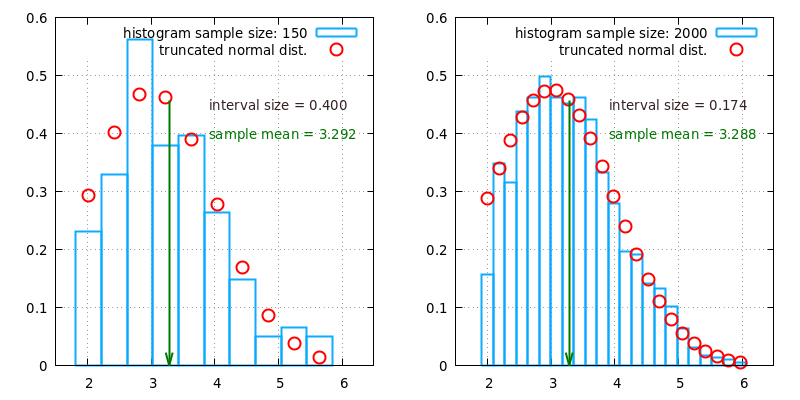sample_statistics 0.1.2  sample_statistics: ^0.1.2 copied to clipboard
sample_statistics: ^0.1.2 copied to clipboard
Sample statistics, histograms, probability distributions, and random sample generators for Dart.
Sample Statistics #
Introduction #
The package sample_statistics provides helpers for
calculating statistics of numerical samples and generating/exporting
histograms. It includes common probability
distribution functions, an approximation of the error function,
and random sample generators.
Throughout the library the acronym Pdf stands for Probability Distribution Function, while Cdf stands for Cummulative Distribution Function.
Usage #
To use this package include sample_statistics
as a dependency in your pubspec.yaml file.
1. Sample Statistics #
To access sample statistics use the class Stats.
It calculates sample statistics in a lazy fashion and caches results
to avoid expensive calculations if the
same quantity is accessed repeatedly. If the random sample changes
use the method updateCache() to recalculate the sample statistics.
import 'package:sample_statistics/sample_statistics.dart'
void main() {
final sample = <num>[-10, 0, 1, 2, 3, 4, 5, 6, 20]
final stats = Stats(sample)
print('\nRunning statistic_example.dart ...')
print('Sample: $sample')
print('min: ${stats.min}')
print('max: ${stats.max}')
print('mean: ${stats.mean}')
print('median: ${stats.median}')
print('first quartile: ${stats.quartile1}')
print('third quartile: ${stats.quartile3}')
print('standard deviation: ${stats.stdDev}')
final outliers = sample.removeOutliers();
print('outliers: $outliers')
print('sample with outliers removed: $sample');
// Update statistics after sample has changed:
stats.updateCache();
}
Click to show console output.
$ dart sample_statistics_example.dart
Running sample_statistic_example.dart ...
Sample: [-10, 0, 1, 2, 3, 4, 5, 6, 20]
min: -10
max: 20
mean: 3.4444444444444446
median: 3
first quartile: 1
third quartile: 5
standard deviation: 7.779960011322538
outliers:[-10, 20]
sample with outliers removed: [0, 1, 2, 3, 4, 5, 6]
2. Random Sample Generators #
The library sample_generators includes functions for generating random samples
that follow the probability distribution functions listed below:
- normal distribution,
- truncated normal distribution,
- exponential distribution,
- uniform distribution,
- triangular distribution.
Additionally, the library includes the function randomSample
which is based on the rejection sampling method.
It expects a callback of type ProbabilityDensity
and can be used to generate random samples that follow
an arbitrary probability distribution function.
The program listed below demonstrates how to generated a random sample and write a histogram to a file.
import 'dart:io';
import 'package:sample_statistics/sample_statistics.dart';
void main(List<String> args) async{
final xMmin = 1.0;
final xMmax = 9.0;
final meanOfParent = 5.0;
final stdDevOfParent = 2.0;
final sampleSize = 1000;
// Generating the random sample with 1000 entries.
final sample = truncatedNormalSample(
sampleSize,
xMmin,
xMmax,
meanOfParent,
stdDevOfParent,
);
final stats = Stats(sample);
print(stats.mean);
print(stats.stdDev);
print(stats.min);
// Exporting a histogram.
// Export histogram
await File('example/data/truncated_normal$sampleSize.hist').writeAsString(
sample.exportHistogram(
pdf: (x) =>
truncatedNormalPdf(x, xMin, xMax, meanOfParent, stdDevOfParent),
),
);
}
3. Generating Histograms #
To generate a histogram, the first step consists in dividing the random sample range into a suitable number of intervals. The second step consists in counting how many sample entries fall into each interval.
The figures below show the histograms obtained from two random samples that
follow a truncated normal distribution with
xMin = 2.0, xMax = 6.0 and normal parent distribution
with meanOfParent = 3.0, and stdDevOfParent = 1.0.
The random samples were generated using the function
truncatedNormalSample.

The figure on the left shows the histogram of a sample with size 150. The figure on the right shows the histogram of a sample with size 600. Increasing the random sample size leads to an increasingly closer match between the shape of the histogram and the underlying probability distribution.
Using the distribution parameters mentioned above with the function
meanTruncatedNormal, one can determine
a theoretical mean of 3.2828. It can be seen that in the limit of a
large sample size the sample mean approaches
the mean of the underlying probability distribution.
The histograms above were generated using the extension method
exportHistogram (see source code above).
Internally, this method uses the class method
histogram provided by the class Stats.
It returns an object of type List<List<num>> holding three sub-lists:
- The first entry contains the central values of the histogram intervals or bins.
- The second entry contains a count of how many sample values fall into each interval. By default, the count is normalized such that the total area under the histogram is equal to 1.0. This is useful when comparing a histogram to a probability density function (see above).
- The third list entry contains the values of
probabilityDensity, a function of typeProbabilityDensityevaluated at each interval mid-point. It no probability density is provided,normalPdfis used.
Examples #
For further examples on how to generate random samples, export histograms, and access sample statistics see folder example.
Features and bugs #
Please file feature requests and bugs at the issue tracker.